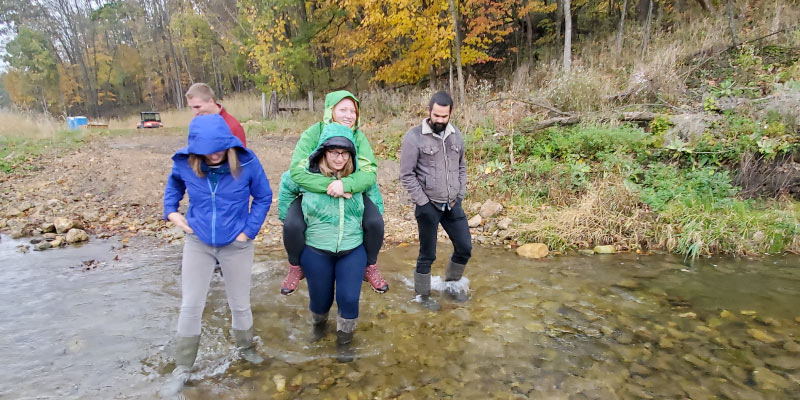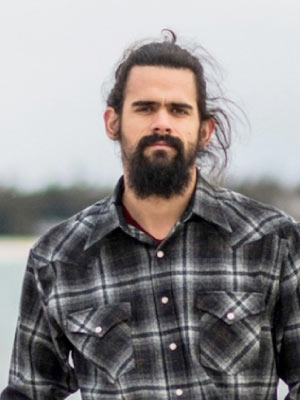
As a journalist in northeastern Wisconsin, Nelson Institute alumnus Jackson Parr often found himself writing about flooding and water quality issues. Seeing his community face these challenges time and time again inspired him to make a change. So, he applied to graduate school at the University of Wisconsin-Madison to gain new skills that would allow him to aid rural communities facing water challenges.
Having observed the connections between tourism, agriculture, and water, Parr knew he would need to understand policy to make a change, so he sought his Master’s in Public Affairs from from the LaFollette School of Public Affairs. The program has a flexible curriculum that allows students to take classes in departments across campus and Parr found himself drawn to environmental studies.
“I found myself just gravitating towards environmental science in the Nelson Institute and that is when the Water Resources Management program came to my attention,” Parr said. “I added that program after my first semester of graduate school.”
The Nelson Institute Water Resources Management (WRM) program prepares students to address the complexities that come with managing this critical natural resource. This is done through a combination of courses and hands-on education that includes a practicum where graduate students work on an issue facing a local community. Students work in cohorts to carry out an applied two-year project that culminates in a report that provides water management recommendations to community leaders.

“My cohort of five other students and I were tasked with looking at flood resilience in the Coon Creek Watershed in the Driftless region, it’s pretty rural,” Parr said. “They had some dam breaches in August 2018 that really created some devastating flooding in the region. So, we were tasked with looking at ways to improve flood resilience and one of the really cool things about WRM is they really give you a lot of latitude to decide how you want to tackle the project that you’re given. So, with me coming from more of a social science, policy, journalism background, I was given the opportunity to do a lot of work on qualitative research and interviews with residents in the area to get a public perspective on flooding and resilience.”
While Parr focused on the policy and the people, other team members focused on the fieldwork including infiltration readings and determining rainfall. Parr also had the opportunity to work with his cohort on the socioeconomics of flooding in the region.
“That project was pretty influential,” said Parr. “Until that project, my world was kind of more in agriculture and water quality. Now, I find myself working exclusively in flood mitigation, and I love it, but I don’t think that that would have happened, had I not been given that project in the WRM program and also been given the latitude to explore it in a way that suits my interests and strengths.”
Eric Booth, an advisor with the WRM program and an associate scientist in the Department of Agronomy, Department of Civil & Environmental Engineering, and the Nelson Institute for Environmental Studies, added, “Jackson has been a fantastic colleague on the Water Resources Management Practicum project exploring flood resilience in the Coon Creek Watershed. He has demonstrated strong leadership, a passion to truly make an impact on communities across Wisconsin, and a deep curiosity to explore the complex interconnections between water, land, climate, public policy, and economics.”
Today, Parr is a fellow with Wisconsin Sea Grant, a program based at the University of Wisconsin-Madison that does basic and applied research, education, and outreach that is focused on Great Lakes resources. He is currently working on a project in partnership with the Wisconsin Department of Health Services to better understand flood resilience and how it relates to public health and climate issues. He is developing a flood resilience scorecard, a community self-assessment of flood risk, as a part of this project. Using the scorecard feedback and data, Parr provides recommendations on ways to improve flood resilience.
Moving forward, Parr plans to continue to apply what he’s learned towards community outreach and flood resilience planning. He is particularly hopeful that new policies will aid in his goal of helping rural communities to protect their water resources.
“One of the things that I’m really interested in is a discussion that’s percolating in a lot of arenas given the new infrastructure bill that just passed at the federal level, is the ability for smaller, often rural, under resourced communities to participate in flood resilience programs,” said Parr. “There’s a lot of these big programs that rural communities and under resourced communities just don’t have the capacity to participate in. That leaves them more disadvantaged relative to more urban or wealthier communities that have the technical or administrative capacity to participate in these programs. I’m really interested in figuring out a way to assist these under resourced communities in accessing funds that would otherwise flow towards places that maybe don’t need them quite as much. I just want to make sure that these communities have equal access to the programs that are often intended for them.”
Learn more about the Water Resources Management program and how you can support the program.